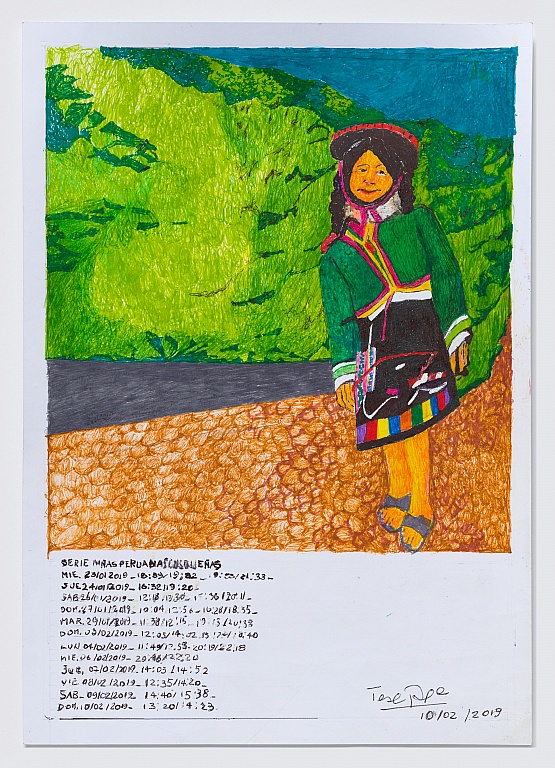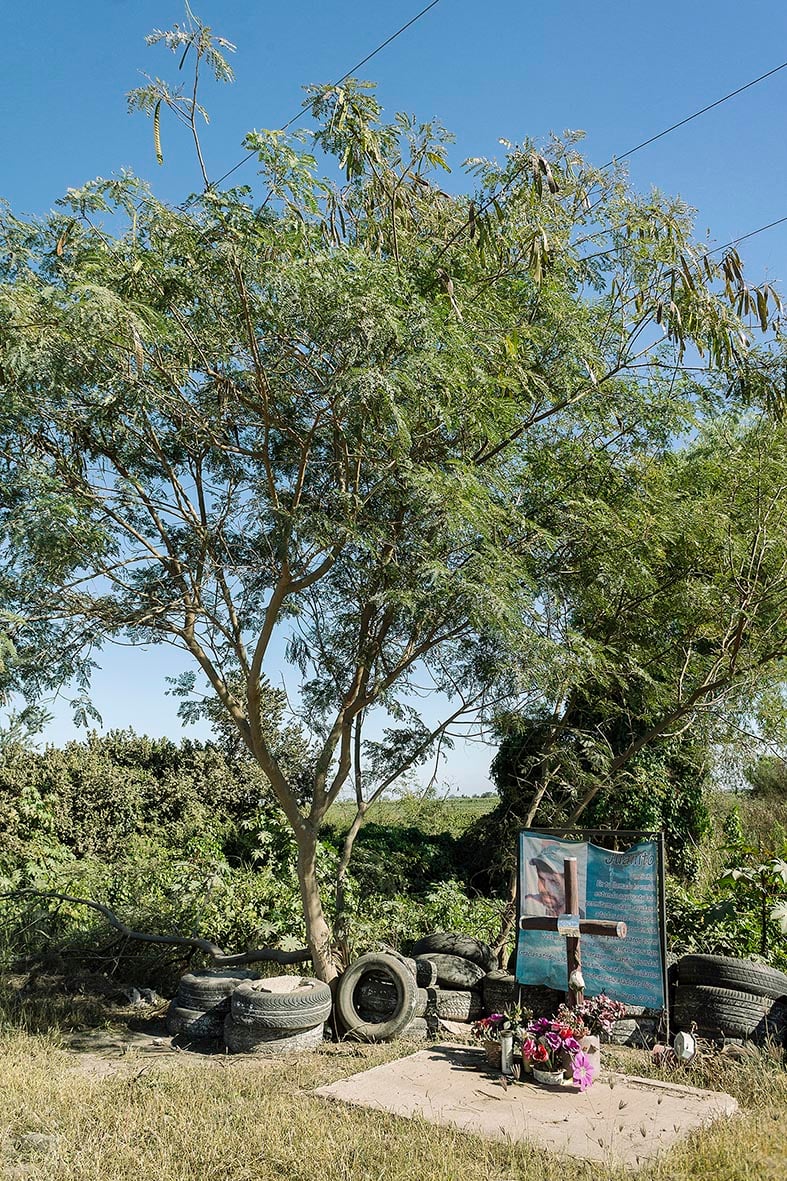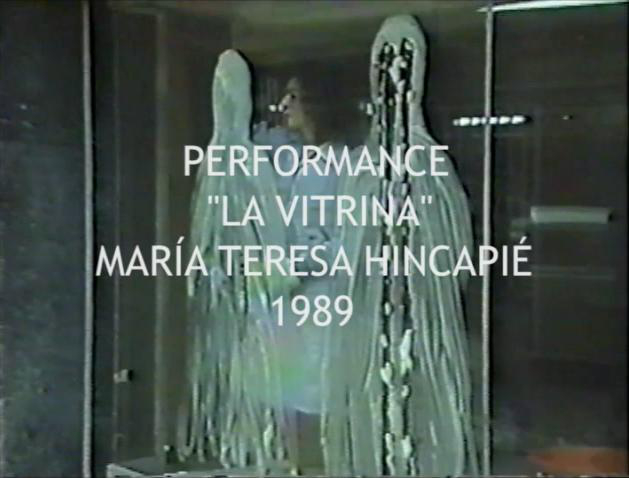
© » KADIST
Alejandro Almanza Pereda
This still life falls apart, or rather floats apart as the composition is proved unstable and constantly morphing. An impossible attempt at achieving a fixed state, some objects remain buoyant and some objects sink, constantly tilting the overall scale and arrangement. Properties of weight, mass and shape have their own will but a hand appears in the scene, pushing back on these mysterious forces.

© » KADIST
Alejandro Marré
Typical Weapons is a series of sculptural interventions where Alejandro Marre transforms traditional Guatemalan craft objects usually sold as souvenirs into weapons. Wooden flutes, hacky sacks, and musical instruments are woven with rope to appear as nunchucks, slingshots, and other forms of armament. Designed to be exhibited as objects from an archaeological museum, the previously innocuous representations of Guatemalan popular culture acquire darker meanings as they come to symbolize the brutality and extreme violence that now mark the country.

© » KADIST
Alexandra Pirici
Furthering Alexandra Pirici’s enquiry into the economy and circulation of artworks, Parthenon Marbles is an immaterial version of the sculptural ensemble embodied by five performers. This ongoing performative action presents and addresses the challenges in the financial and legal implications and value of the original sculptures as cultural capital. The original Parthenon Marbles are a collection of Classical Greek marble sculpture inscriptions and architectural pieces that were originally part of the temple of the Parthenon and other buildings in the Acropolis of Athens, Greece.

© » KADIST
Rajni Perera
Drought Mask by Rajni Perera is a prototype that is suggestive of dire implications for human survival. Directly addressing the urgent climate crisis, specifically wide-spread drought, this sculpture imagines hybrid cultural aesthetics of the near-future after global collapse. Composed of various woven textiles complete with frills and fringes, leather, a gas mask, and pencil, Rajni’s mask prefigures future dystopian characters who are resilient and resourceful; self-fashioning tools for survival.

© » KADIST
Alessandro Balteo Yazbeck
Part of a larger series of photographic works, Alessandro Balteo Yazbeck’s Corrupted file from page 14 (V1) from the series La Vega, Plan Caracas No. 1, 1974-1976 presents an interrupted image. The images capture scenes from an urban development, La Vega, built to modernize and connect favelas in Venezuela.

© » KADIST
Alexandre Arrechea
White Corner (2006) is a video installation, projected on two protruding perpendicular walls. On one level the work constitutes a self-portrait of the artist, whose image is projected on both walls, separated by the corner. Yet while facing, they don’t quite confront each other.

© » KADIST
Teresa Burga
Drawing & Print (Drawing & Print)
In her new series titled Ninas Peruanas Cusquenas , Teresa Burga depicts young indigenous women from Peru’s Andean region, dressed in traditional garments. Sourcing imagery from the internet, the drawings recall an untitled series of drawings from 1974, in which Burga selected images of women at random from various print media, and then rendered the images on paper. Those drawings, like the newer ones, suggest the perils of images without context––how assumptions are made, stereotypes are formed, and knowledge is gathered.

© » KADIST
Ron Terada
Drawing & Print (Drawing & Print)
The three Maiko s were included in Ron Terada’s 2008 exhibition, Voight–Kampf , at Catriona Jeffries gallery. More ambitious in size and subject matter, this show with its complex video installation marked a new path for Terada’s work. Voight-Kampf is based on a scene from Ridley Scott’s 1982 movie Blade Runner in which a giant advertising billboard in the midst of a dystopian city of Los Angeles in the future displays a geisha eating candy.

© » KADIST
Sinzo Aanza
Projet d’attentat contre l’image? (Acte 3) by Sinzo Aanza brings together literature and objects in their varied forms. This project stems from the artist’s interest in the syncretism that emerged after Congo’s independence in 1960.

© » KADIST
Teresa Margolles
Stretching between San Pedro and the beach in Altata, Sinaloa, there is a 40 km road where there are three invisible borders controlled by rivalling armed groups. There is a price to pay for crossing these territories. This series of 21 photographs by Teresa Margolles, titled 40 Km , resemble snapshots of peaceful lands, but also bear witness to the reality lived by the local people in this area.

© » KADIST
Nohemí Pérez
Drawing & Print (Drawing & Print)
A rich and isolated region, El Catatumbo is located near the border with Venezuela. Different groups fight over its gold and oil, while narcotic plantations have exploited the region over the years, provoking massacres, displacement, and migrations amongst its native populations. Nohemí Pérez’s skillful and eloquent watercolors, titled Apuntes para panorama Catatumbo , testifies to this aspect of Colombia’s history that has been veiled by other equally pressing political issues.

© » KADIST
Amapola Prada
In Amapola Prada’s work Movement, we see three spotlit, female bodies lying inert in a darkened room, alongside three dressed, standing figures holding long, wooden spoons. Looking over the static bodies, the standing figures place their spoons in-between the women’s legs and begin moving them in circular, rowing-like motion, like the oars of a boat. The psycho-sexually charged nature of Movement is illustrative of Prada’s dream-like works, which often relate to the subconscious and other internal processes with which we express desires, tensions, and latent emotions.

© » KADIST
Amapola Prada
n the opening scene of the video Power (La Fuerza) we see a mature woman asleep in a dark room. Prada slowly becomes visible as she crawls into the bed and affectionately positioning her body next to the sleeping figure. Prada then proceeds to undress the woman’s chest and ‘feed’ from her breast.

© » KADIST
Amapola Prada
In the video Unit/y we see Amapola Prada in the center of the screen wearing an oversized, worn out sweatshirt, socks and flip-flops—standing motionless on a dimly lit street in her native Lima, Peru. As the video progresses, people, stray dogs, and cars pass by unbeknown to her presence, inescapably fulfilling their roles in the everyday. The title of the work gives us a clue.

© » KADIST
Alexandre da Cunha
His Deck Painting I recalls the simplistic stripes of conceptual artist Daniel Buren, or the minimal lines of twentieth century abstract painting, but is in reality a readymade, fashioned from repurposed fabric of deck chairs. Alexandre da Cunha reinvents found objects in surprising ways that combine the material characteristics of Arte Povera with the concerns and techniques of painting. Da Cunha’s work often features flags—either as a found material per se or as a constructed form—that reflect the artist’s interest in issues of nationality, governmental politics, allegiance, and culture.

© » KADIST
Alexandre da Cunha
Glaze (Savana) (2005) is an assemblage of found materials: a car wheel, a tire, and a wooden plinth of the type traditionally used to display sculpture. It directly engages with the readymade, a subject that Alexandre de Cunha takes up throughout his practice, often inflecting it with a tropical, and South American–inspired materiality and painterly style that could potentially come across as a stereotype. Here, da Cunha transforms the component parts into a composition that highlights often-overlooked materials of artistic production and cultural mass-production.

© » KADIST
Alexandre da Cunha
In Laissez-Faire (Rainbow Flag) da Cunha has turned a beach towel into both a painting and a flag. Where the printed surface of the towel originally served to enliven this commodity, here the pattern—now stretched and re-presented—suddenly refers to abstract painting’s promises of transcendence. And its crisply painted shape pulls the printed colors into the rectangularity of the canvas and, as da Cunha notes, the graphic iconicity of flags.

© » KADIST
Alexandre da Cunha
The series West (Flag 1), West (Flag 3), and West (Flag 6) continues da Cunha’s ongoing exploration of the form’s various vertical, horizontal, and diagonal stripes. Here, da Cunha overlays thick bars of color (blue, green, and red) on photographs of the ocean at sunset with surfers in floating on the horizon. The solid colors contrast with the fading colors reflected in the sunset, and the tilted orientation suggests a familiar California beach scene.

© » KADIST
Ana Teresa Fernández
Drawing & Print (Drawing & Print)
The artist writes about her work Borrando la Frontera, a performance done at Tijuana/San Diego border: “I visually erased the train rails that serve as a divider between the US and Mexico. I painted them sky blue, creating a “Hole in the Wall” This deconstruction of “feminized” work explores the difficulties in reconciling both low wages and undervalued work via social and political infrastructures, confronting issues of labor and power. The images that I myself perform, present a duality: women dressed in a black tango dance attire while engaging in de-skilled domestic chores; the surreal within non-fiction.

© » KADIST
Andrés Pereira Paz
Juan III (Pescadores En Una Isla) is a series of embroideries made with fake pre-Columbian fabrics produced by the Gonzales family, a three-generation family of pre-Columbian textile “forgers” based in Lima, Peru. The members of this family (grandfather, father, and son) all bear the name of Juan and make replicas by hand using traditional methods nearly indistinguishable from the pieces made thousands of years ago. A forgery pretends to be something it is not, but the Gonzalez family’s textiles openly intend to recreate those discovered in the 1920s at a necropolis in Peru.

© » KADIST
María Teresa Hincapié
In the performance video Vitrina , María Teresa Hincapié stood inside a storefront window in downtown Bogota, unannounced, for eight hours a day, wearing a uniform and initially carrying out cleaning chores. As the day and passers went by, the routine became more playful: she would send kisses to bus drivers on the busy Avenida Jiménez who would return them, use the newspaper with which she was shining the glass to flirtatiously hide and engage with an improvised audience or draw the shape of her body with soap and a sponge. She would interrupt these chores to carry out other ‘feminine’ activities, like brushing her hair or applying make-up, only to return to frantically cleaning the transparent surface that separated her from the public.
Alexandre da Cunha
- location: London, United Kingdom
- year born: 1969
- gender: male
- nationality: Brazilian
- home town: Rio de Janeiro, Brazil
Amapola Prada
As the daughter of an actor, Amapola Prada recalls frequently attending the theater as a child and noticing that she never saw herself (her body or reality) represented...
Alejandro Almanza Pereda
Alejandro Almanza Pereda has a heightened understanding of the essence of objects...
Teresa Burga
A pioneer of Latin American Conceptualism, since the 1960s, Teresa Burga has made works that encompass drawing, painting, sculpture, and conceptual structures that support the display of analytical data and experimental methodologies...
Teresa Margolles
Teresa Margolles’s work examines the social causes and consequences of violence...
Ron Terada
Ron Terada belongs to a generation of Vancouver-based artists that follows the well-known Vancouver School of photoconceptualists which includes Jeff Wall, Stan Douglas, and Ian Wallace...
Sinzo Aanza
Sinzo Aanza is a visual artist, poet, and playwright...
Rajni Perera
Rajni Perera’s practice foregrounds a hybrid model that merges immigrant politics, feminine power, mythology, and science fiction...
Alessandro Balteo Yazbeck
- location: Berlin, Germany
- year born: 1972
- gender: male
- nationality: Venezuelan
- home town: Caracas, Venezuela
Alexandra Pirici
The performative work of Alexandra Pirici (b...
-
1980-1989
María Teresa Hincapié
1989In the performance video Vitrina , María Teresa Hincapié stood inside a storefront window in downtown Bogota, unannounced, for eight hours a day, wearing a uniform and initially carrying out cleaning chores...
-
2000-2009
Alexandre da Cunha
2005His Deck Painting I recalls the simplistic stripes of conceptual artist Daniel Buren, or the minimal lines of twentieth century abstract painting, but is in reality a readymade, fashioned from repurposed fabric of deck chairs...
Alexandre da Cunha
2005Glaze (Savana) (2005) is an assemblage of found materials: a car wheel, a tire, and a wooden plinth of the type traditionally used to display sculpture...
Alexandre Arrechea
2006White Corner (2006) is a video installation, projected on two protruding perpendicular walls...
Alejandro Marré
2007Typical Weapons is a series of sculptural interventions where Alejandro Marre transforms traditional Guatemalan craft objects usually sold as souvenirs into weapons...
Alessandro Balteo Yazbeck
2008Part of a larger series of photographic works, Alessandro Balteo Yazbeck’s Corrupted file from page 14 (V1) from the series La Vega, Plan Caracas No...
Ron Terada
Drawing & Print
2008(Drawing & Print) The three Maiko s were included in Ron Terada’s 2008 exhibition, Voight–Kampf , at Catriona Jeffries gallery...
-
2010-2019
Alexandre da Cunha
2010In Laissez-Faire (Rainbow Flag) da Cunha has turned a beach towel into both a painting and a flag...
Alexandre da Cunha
2011The series West (Flag 1), West (Flag 3), and West (Flag 6) continues da Cunha’s ongoing exploration of the form’s various vertical, horizontal, and diagonal stripes...
Ana Teresa Fernández
Drawing & Print
2011(Drawing & Print) The artist writes about her work Borrando la Frontera, a performance done at Tijuana/San Diego border: “I visually erased the train rails that serve as a divider between the US and Mexico...
Amapola Prada
2013In Amapola Prada’s work Movement, we see three spotlit, female bodies lying inert in a darkened room, alongside three dressed, standing figures holding long, wooden spoons...
Amapola Prada
2013n the opening scene of the video Power (La Fuerza) we see a mature woman asleep in a dark room...
Amapola Prada
2013In the video Unit/y we see Amapola Prada in the center of the screen wearing an oversized, worn out sweatshirt, socks and flip-flops—standing motionless on a dimly lit street in her native Lima, Peru...
Teresa Margolles
2014Stretching between San Pedro and the beach in Altata, Sinaloa, there is a 40 km road where there are three invisible borders controlled by rivalling armed groups...
Alejandro Almanza Pereda
2015This still life falls apart, or rather floats apart as the composition is proved unstable and constantly morphing...
Nohemí Pérez
Drawing & Print
2016(Drawing & Print) A rich and isolated region, El Catatumbo is located near the border with Venezuela...
Sinzo Aanza
2017Projet d’attentat contre l’image? (Acte 3) by Sinzo Aanza brings together literature and objects in their varied forms...
Andrés Pereira Paz
2018Juan III (Pescadores En Una Isla) is a series of embroideries made with fake pre-Columbian fabrics produced by the Gonzales family, a three-generation family of pre-Columbian textile “forgers” based in Lima, Peru...
Teresa Burga
Drawing & Print
2019(Drawing & Print) In her new series titled Ninas Peruanas Cusquenas , Teresa Burga depicts young indigenous women from Peru’s Andean region, dressed in traditional garments...
-
2020-2029
Rajni Perera
2021Drought Mask by Rajni Perera is a prototype that is suggestive of dire implications for human survival...